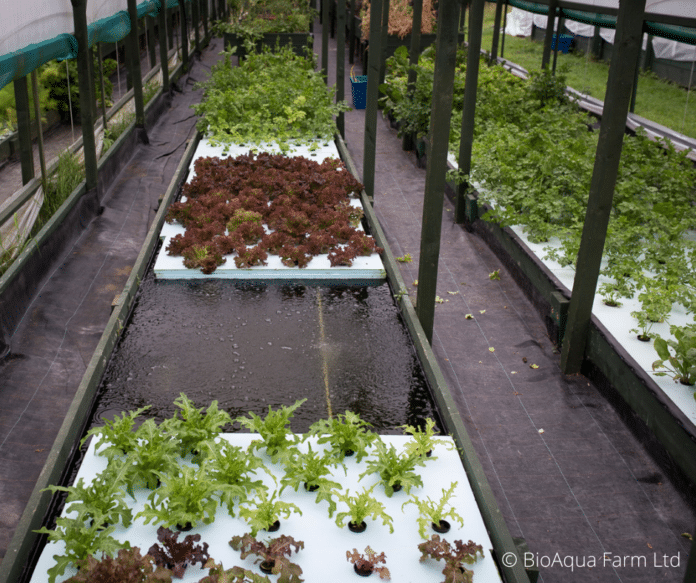Food production and diets are in need of change and innovation. Aquaponics is a food production system that combines aquaculture with hydroponics. It produces two crops, fish and plants, at the same time. The system works according to circular economy where nothing is aimed to be wasted. It could bring more local, healthier and environmentally sustainable fish and plants to people’s tables around the world.
Food production in crisis

Current food production has been heavily linked to climate change and biodiversity loss. However, people need to eat on a daily basis. Many questions surrounding the issues become more relevant:
How can we reduce methane emissions from agriculture? What is going to happen when a growing global population eats more fish and seafood from already depleted stocks? How can we bring about food production that creates a balance between the needs and wellbeing of the people and those of the planet?
Overfishing and illegal fishing activities are severe issues in different areas of the world. Conversely, conventional aquaculture is often proposed to fulfill the dietary needs of the growing global population. However, conventional models have their remaining issues, such as nutrient emissions that destroy the surrounding ecosystems.
Meanwhile, industry pollution and plastic waste, found in the ecosystems worldwide, threaten the healthiness and safety of food of every citizen.

A changing climate is further pushing food production and systems to become more resilient, innovative and adaptive.
New (and ancient) concepts for the win
Aquaponics combines aquaculture with hydroponics (soiless plant production). In this food production fish and plant units are combined into an integrated and symbiotic system. Aquaponics is a system that functions within the circular economy that aims to use everything and waste nothing.
The main goal in aquaponic systems is to create plant growth by using aquatic animal waste. Consequently, aquaponics uses the fish waste as a fertilizer for the plants while the plants clean the water for the fish. The plants benefit from the existence of the fish and the other way around. The system creates a symbiotic and beneficial relationship between the two actors.
Aquaponics as a concept is ancient. It was already known to have been used in Ancient China and Aztec Empire without modern science and technology to produce a variety of foods. The concept follows and mimics the cycles happening in wild nature as we speak.
There is a remaining floating island called “Chinampa” in the capital of Mexico. Mexico City during pre-Columbian era used to function as the Aztecs’ capital Tenoctitlan. Chinampa uses circularity to produce food for one of the most populated cities on the Earth, and it has been given the status of agricultural heritage by FAO.
The ancient concept known by the Aztecs is now increasing curiousity around the world for its ability to use resources efficiently and avoid waste creation. Conventional food production often relies on linear economy where waste is simply being disposed at the end.

Aquaponics as a circular method has its advantages. One of the main benefits of aquaponics is in its ability to save in water use since the system recycles the water to be used again and again. Consequently, using aquaponics may enable the producer to use only 10% of water resources in comparison to conventional food production methods.
Another main benefit of the closed system is that it avoids creating waste, one of the main issues within food production currently. In aquaponics the plants use the fish waste as a fertilizer, and therefore the system brings environmental and economic benefits. Conventional linear systems that dispose the fish waste into the environment, do not take use of the nutrient potential in it.
Addressing many goals at once
With modern science and technology, aquaponics can be scaled into different sizes and be placed in various places – including rooftops, balconies and basements. Vertical farming aims to use land in a more efficient way, and this is very important in an era when land restoration is needed for healthier ecosystems.

Aquaponics can therefore bring food production into cities and places without access to natural soil or waterbody. Since the closed system can be separated from wild nature, it reduces the food’s likeliness to be subject to pollution or unexpected climate conditions occuring outside.
The system can bring not only environmental and health benefits, but it can also bring socio-economic ones. Aquaponics promotes sustainable local food systems and production that support local communities, jobs, economies and livelihoods.
In consequence, aquaponics is an example of an innovation and opportunity for the world to address several sustainable development goals at the same time.
Have you ever seen an aquaponics system before? Take a look at the video to see aquaponics and learn about its potential in resolving issues within the food system:
Learn more about the importance of conserving and restoring the world’s oceans
Oceans Decade: Science as a tool for a healthier ocean
Want to learn to create your own aquaponic unit in your own home? Learn more here.
More about aquaponics on FAO website.

